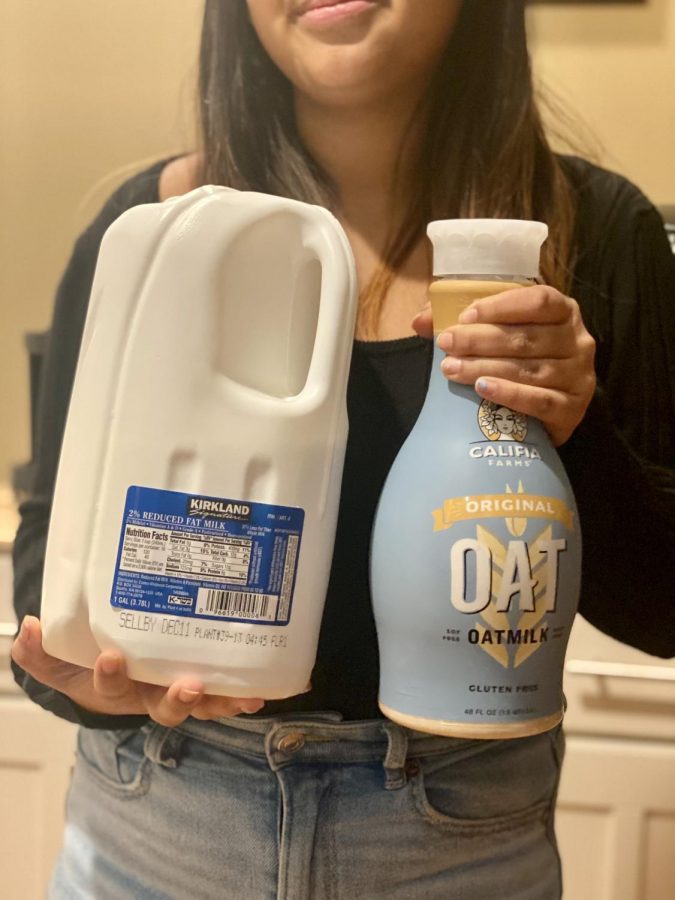May contain traces of…
What it’s like in school with food allergies
Photo by Sashrika Shyam
At Jazzmans, it costs $0.50 more to get a non-dairy milk substitute with a drink, making it difficult for those with dairy allergies to be included. Traditional dairy milk has some substitutes for those who are allergic, such as oat, almond, and soy milk.
I look like everyone else. I dress the same as you, walk the same halls as you, probably like the same music as you. But I’m different. And the cafeteria makes money off my differences.
I — along with roughly 5.6 million other teens — suffer from food allergies. But unlike a lot of students here, I’m allergic to more than just peanuts, the most common food allergy in kids, according to Food Allergy Research and Education, the world’s largest food allergy non-profit organization. I can’t have dairy, which includes milk, butter, or cheese. I also can’t eat eggs, chicken, beef, pork, steak, fish, shrimp, or lobster. No scrambled eggs for breakfast, no ice cream for dessert, and a lot of other “no’s” in between. This is my life.
I’ve grown accustomed to not being able to eat at most places, but throughout the years there have been more options for those with allergies. For example, more varieties of non-dairy milk have appeared in stores, many companies are making vegetarian and vegan meals, and there’s non-dairy ice cream and cheese. Yet our school is still behind.
Every day, many students eat lunch from the cafeteria or get a drink from Jazzmans. These students probably don’t think about the ingredients in the meals they buy, or even realize that most of the prepackaged meals served in the school don’t have any ingredients on them. But for me it’s a daily struggle because if I eat one of the foods I’m allergic to, I experience severe nausea and vomiting. And if I want to get a coffee to be like everyone else? I pay a premium for protecting my health because I have to get almond or soy milk, which costs me $0.50 more than other students pay for coffee with normal milk.
It’s nice to feel included when I buy drinks from Jazzmans, due to the other options. But a medium coffee is $4.00 just because I can’t have “normal” milk. The most I can get at the cafeteria is a drink and some chips. I have to make my lunch the night before school, every day. I do not have the luxury of just getting lunch at school if I forget my lunch.
According to the head of the school’s food service provider, Kathy Taylor, all products prepared on site are peanut free, and the school is working towards putting ingredients on all Grab and Go items. Taylor also says that the extra charge on almond and soy milk is due to the original cost being about double that of regular milk.
While it is understandable that these special products cost more to get for providers or for the school, it is still frustrating for me to not have any options at the cafeteria. It doesn’t matter if a food item “looks” safe, there are still issues of cross contamination and it is not worth the risk. I am not asking for every item in the cafeteria to be perfectly safe or the cost of almond milk at Jazzmans to be $0, but it would be nice to at least know there is something vegan at the cafeteria, or for the cost of non-dairy milk to be less than 50 cents. I would like to be able to feel like a normal student, and be like everyone else.

During her third and final year on the Bear Facts staff, Sashrika is looking forward to assuming her role as LZ Life Editor and Social Media Manager. When...


John Lambrechts • Jan 19, 2022 at 7:24 pm
Sashrika, you are very smart. I graduated LZHS in 2008 and would have definitely been your friend if I was in your year. Keep up the good journalism and I hope you get paid and become famous.
Could you analyze the affects of Collagen Peptides and Hemp on the Human System?